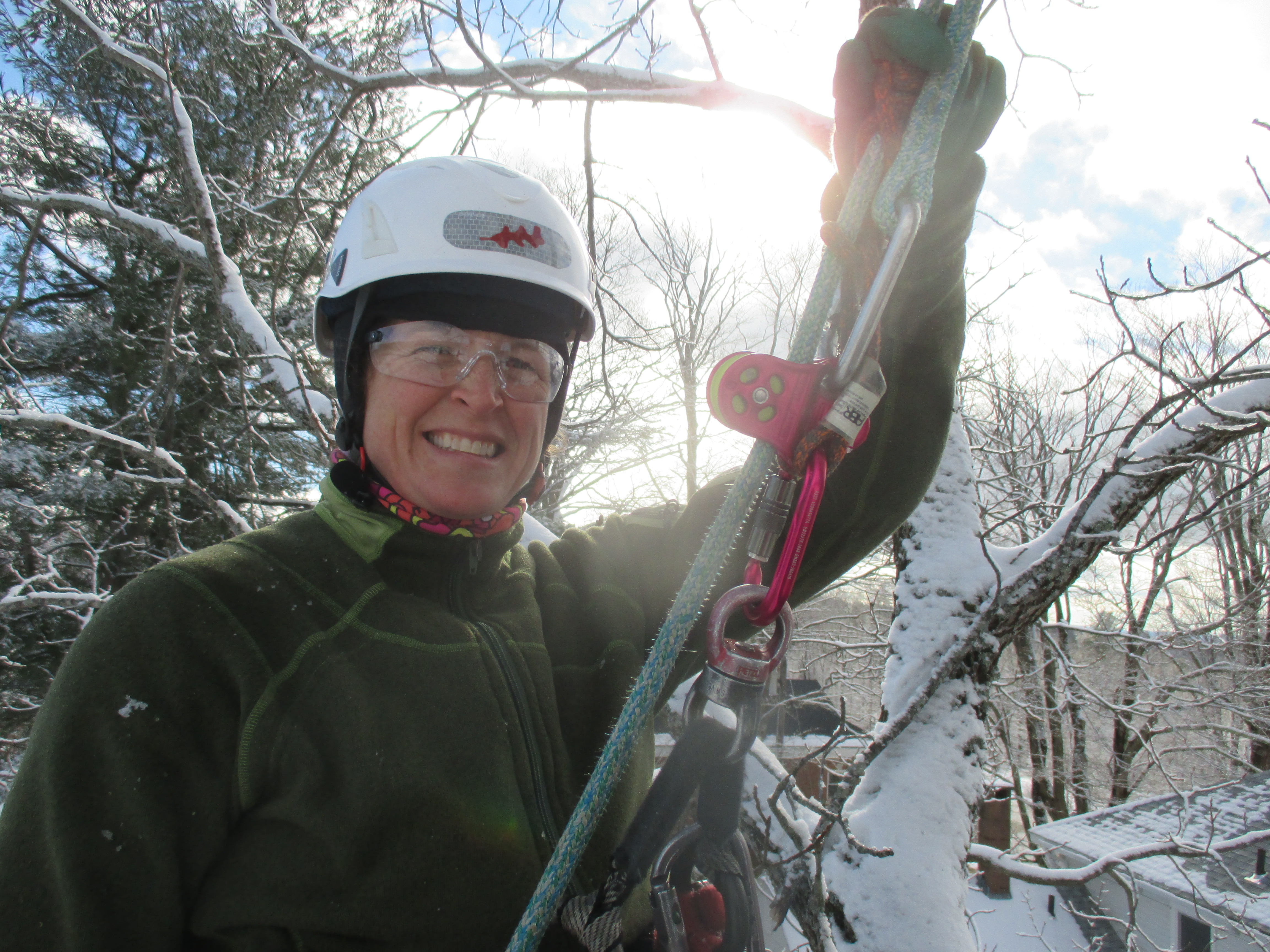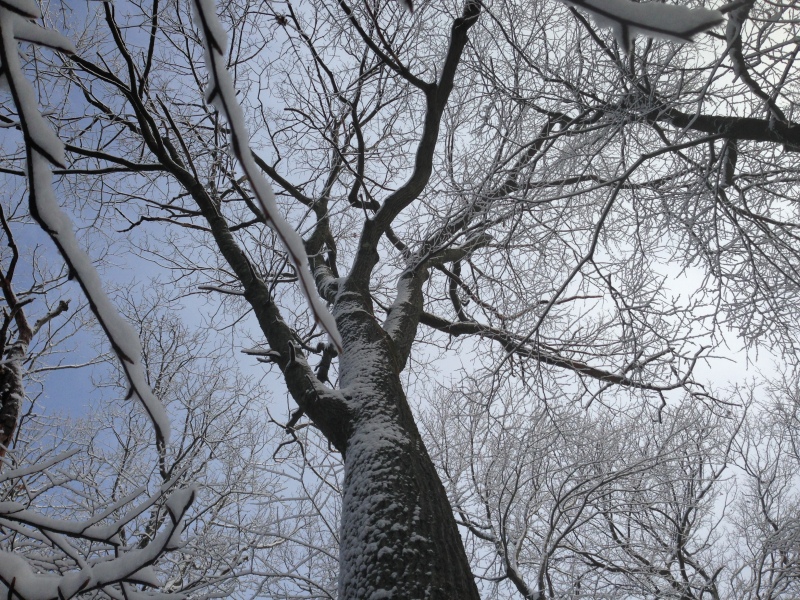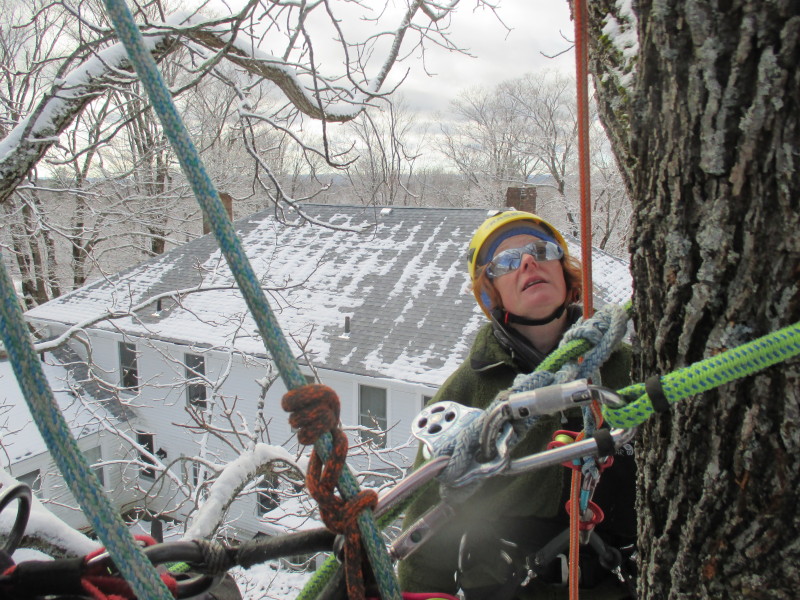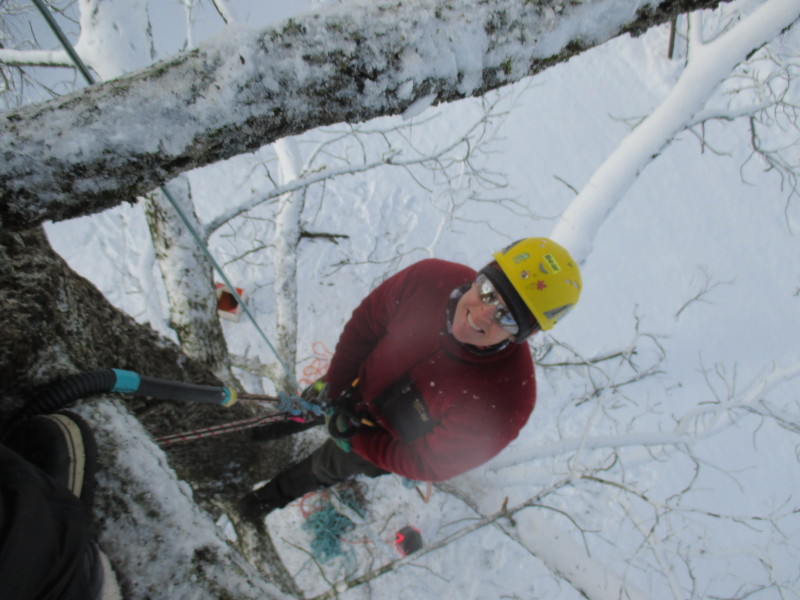PRACTICE MAKES…BETTER. CLIMBING THE BLACK WALNUT
What does a tree feel like in winter?
There was only one way to find out, I figured, so last weekend, up a black walnut I went. Higher and higher, above the roof of the house where I live, knocking snow off limbs as I went. And getting snowed on too, by my climbing companions above me.
This all got started last year when I committed to looking long and deep at the life story of a single, 100-year old tree at the Harvard Forest. I knew then I would want to climb that tree — and that it would take professional help. It’s a tall order, literally, a big red oak, more than eight stories high, with no branches at all for the first 40 or so feet. Pretty intimidating. But I was going to be at the Harvard Forest all year as a Bullard Fellow in forest research, writing my book, Witness Tree. I figured getting my arms around it – literally – was part of what I was in this for. My dream ultimately, we’ll see if I manage it, is to get comfortable enough to write up there. Go up with my notebooks and sketch, and take notes, record birdsong, maybe even haul up the laptop and have at it. Why not write from the trees? What would it be like to spend an afternoon in a tree like that, to be part of its canopy life?
Melissa LeVangie, the tree warden for Petersham, gave me my first climbing lesson last month, gamely getting me way up into the tree on a first visit, using a climbing harness and ropes. It was an overwhelming, heart pounding fraught peril, this hauling of myself up the rope, or so it felt to my novice self (Melissa made sure I was always utterly safe.) Yet I found, as I made my way into the first branches way up the oak’s trunk, that I liked it up there. I loved the feeling of standing way up in its world, on its terms. I was hooked. We decided to schedule another climbing lesson. This time, we brought reinforcements.
Melissa’s twin sister Bear LeVangie, a champion climber, and two friends from the Knight Science Journalism program at MIT, Rachael Buchanan, a producer at the BBC, and Patrick Wellever, digital media training coordinator for the KSJ program, strapped into harnesses too.
A tree in winter is a different being. I know this tree well: the black walnut we were climbing is right outside my front windows at Community House, where I am living. The walnut tree is the first thing I see every morning when I get up, and the last thing I see on my way to turn in for the night. Like all black walnuts, it is a spectacularly symmetrical, vase-shaped tree that wholly dominates its space. Black walnuts actually emit a chemical from all of their parts that discourages the growth of plants under their canopy. Uncrowded by competition, each branch tapers to twigs and twiglets in perfect fractals. The tree is a math made visible.

The symmetry and low branching habit of the black walnut makes it a good practice climb. Getting started, “low and slow,” at Melissa’s advice.
I’ve watched this tree closely through four seasons, it crowns the meadow where I write in my journal in the morning and evening at a picnic table; it fills the windows of the porch where I write when it’s cold, and it towers over the firepit where we gather sometimes at day’s end. It is festooned with tresses of compound leaves in the spring, aglow in yellow in the fall, and alive with squirrels and birds cruising for nuts as winter comes on. (I saw only two walnuts, this year, visible at the very top of the tree only briefly, before some animal snagged them.)
Winter though is when this tree takes on the spare beauty of a pen and ink drawing, or Japanese scroll painting, all black clean lines that in fresh snow wear an ermine robe.
It had snowed the night before our climb in the walnut. The perfect tree for a training climb, Melissa and Bear picked it for its accessibility. Unlike the fierce oak, this tree had branches almost low enough to touch, and arranged in a regular array that allowed us to climb not only rope, but the tree itself.
With daylight hours short, we got right to it last Saturday morning, at 9 sharp. Cinching our harnesses tight, pushing the tension knot up the climbing rope, and paying out the rope’s tail, up we went, feet off the ground in a dizzying first jolt. Melissa put an ascender on one of my feet so I could push down with my legs to add power to my arms. Up I went, zip, zip, zip. My neck tingled as Rachel, already way above me, stood on a limb over my head, releasing crystal flakes sparkling in the sunbeams and sifting down inside my collar. I knew Patrick was going to be a natural, and sure enough, he was already way above us both, higher than the roof of the house, up where the walnut tree’s trunk starts to narrow.
That’s what I wanted to learn, the physical geometry of the tree, how it felt in my hands and under my feet. And its branches, what would they be like in the cold snowy day? Stiffer. Rigid. The moss on the limbs was packed with snow that caked our ropes. I placed my feet with care as I stood on a limb, and looked out to the pasture I had never seen from up here. The lines of the paths I know so well coalesced in overview, and the cows, as they chewed their morning hay, looked on with seeming curiosity. Whatever would those humans do next?

I knew Patrick would be a natural and he was. On the ground in the distance, the cows take in our antics.
Melissa reminded me to face the tree and its architecture, see that I could climb it, and not just the rope. I raised a leg, kid style, to clamber higher, pulling myself up on the bough overhead. I hadn’t done that since I was about 7, I thought, and as I climbed, the memories flooded back. It was the Eastern red cedar by the frog pond where I grew up, and one day, instead of just leaning against its trunk with a book, up I went. What stayed with me all these years later was the memory of two things: how the view of my world shifted, with my aspect from up high. I was thrilled by the secret world in the tree I discovered, including tiny blue-green berries that grew only up top. But best of all, and I remember it still, was my sense of sovereignty up there. The top of that tree was the first space I had defined for myself, all on my own. I came down when I was good and ready. For dinner, of course.

Melissa’s instruction enabled me to recapture the joy of climbing trees. I want to get good enough at this to enjoy writing aloft in the big oak. We’ll practice every month to savor the trees in the seasons. They feel — and sound — different, month by month. Next time, Patrick and Rachel are going to be packing heat: a GoPro and digital camera to film video.
In the afternoon, we practiced throwing the line into the walnut as if to begin a climb. We tossed a small, weighted bag attached to the orange nylon line with a cat’s cradle maneuver that cranked the momentum of our throw before releasing the line with a hissing swish.
I was cocky about this; I spent hours daily playing catch as a kid, wearing a patch into the front lawn down to dirt where I stood, opposite my brother Matt, whipping a baseball with my long gangly arm and catching it with a satisfying thwack in my leather glove. Sure it was, well, decades later. But still, I figured I’d be an ace with a throw bag.
Wrongo.
The branches catch at the line. And yanking it, I learned, perfectly wedges the bag into the no-man’s land of the tight little nook where the branch joins the trunk. Pull harder, and it sticks…tighter, Chinese finger trap style. Melissa finally had to harness up and go get the thing.
Cold, but exhilarated, we called it a day. The sun was sinking into the trees as we helped Melissa and Bear pack up their gear, and the black walnut was already in evening shadow. The last sun burned on the upper pasture, leading to the woods. Right where this, we all knew, is headed. Next month, we’re tackling the big oak.




Leave a Reply